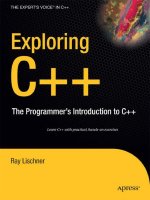Ray lichner - exploring c++ the programmers introduction to c++
Bạn đang xem bản rút gọn của tài liệu. Xem và tải ngay bản đầy đủ của tài liệu tại đây (3.18 MB, 704 trang )
Ray Lischner
Exploring C++
The Programmer’s Introduction
to C++
Exploring C++: The Programmer’s Introduction to C++
Copyright © 2009 by Ray Lischner
All rights reserved. No part of this work may be reproduced or transmitted in any form or by any means,
electronic or mechanical, including photocopying, recording, or by any information storage or retrieval
system, without the prior written permission of the copyright owner and the publisher.
ISBN-13 (pbk): 978-1-59059-749-1
ISBN-10 (pbk): 1-59059-749-4
ISBN-13 (electronic): 978-1-4302-1895-1
Printed and bound in the United States of America 9 8 7 6 5 4 3 2 1
Trademarked names may appear in this book. Rather than use a trademark symbol with every occurrence
of a trademarked name, we use the names only in an editorial fashion and to the benefit of the trademark
owner, with no intention of infringement of the trademark.
Lead Editor: Matthew Moodie
Technical Reviewer: Francis Glassborow
Editorial Board: Clay Andres, Steve Anglin, Mark Beckner, Ewan Buckingham, Tony Campbell,
Gary Cornell, Jonathan Gennick, Michelle Lowman, Matthew Moodie, Jeffrey Pepper,
Frank Pohlmann, Ben Renow-Clarke, Dominic Shakeshaft, Matt Wade, Tom Welsh
Project Manager: Richard Dal Porto
Copy Editor: Octal Publishing, Inc.
Associate Production Director: Kari Brooks-Copony
Production Editor: Ellie Fountain
Compositor: Dina Quan
Proofreaders: Lisa Hamilton and Linda Seifert
Indexer: John Collin
Cover Designer: Kurt Krames
Manufacturing Director: Tom Debolski
Distributed to the book trade worldwide by Springer-Verlag New York, Inc., 233 Spring Street, 6th Floor,
New York, NY 10013. Phone 1-800-SPRINGER, fax 201-348-4505, e-mail kn`ano)ju<olnejcan)o^i*_ki, or
visit dppl6++sss*olnejcankjheja*_ki.
For information on translations, please contact Apress directly at 2855 Telegraph Avenue, Suite 600,
Berkeley, CA 94705. Phone 510-549-5930, fax 510-549-5939, e-mail ejbk<]lnaoo*_ki, or visit
dppl6++sss*]lnaoo*_ki.
Apress and friends of ED books may be purchased in bulk for academic, corporate, or promotional use.
eBook versions and licenses are also available for most titles. For more information, reference our Special
Bulk Sales–eBook Licensing web page at dppl6++sss*]lnaoo*_ki+ejbk+^qhgo]hao.
The information in this book is distributed on an “as is” basis, without warranty. Although every precau-
tion has been taken in the preparation of this work, neither the author nor Apress shall have any liability
to any person or entity with respect to any loss or damage caused or alleged to be caused directly or indi-
rectly by the information contained in this work.
The source code for this book is available to readers at dppl6++sss*]lnaoo*_ki. You may need to answer
questions pertaining to this book in order to successfully download the code.
iii
Contents at a Glance
About the Author xxi
About the Technical Reviewer xxiii
Acknowledgments xxv
Introduction xxvii
PART 1
NNN
The Basics
EXPLORATION 1 Honing Your Tools 3
EXPLORATION 2 Reading C++ Code 13
EXPLORATION 3 Integer Expressions 21
EXPLORATION 4 Strings 27
EXPLORATION 5 Simple Input 33
EXPLORATION 6 Error Messages 39
EXPLORATION 7 For Loops 45
EXPLORATION 8 Formatted Output 49
EXPLORATION 9 Arrays and Vectors 59
EXPLORATION 10 Increment and Decrement 71
EXPLORATION 11 Conditions and Logic 77
EXPLORATION 12 Compound Statements 85
EXPLORATION 13 Introduction to File I/O 95
EXPLORATION 14 The Map Data Structure 99
EXPLORATION 15 Type Synonyms 105
EXPLORATION 16 Characters 109
EXPLORATION 17 Character Categories 115
EXPLORATION 18 Case-Folding 123
EXPLORATION 19 Writing Functions 127
EXPLORATION 20 Function Arguments 137
NCONTENTS AT A GLANCE
iv
EXPLORATION 21 Using Algorithms 145
EXPLORATION 22 Overloading Function Names 157
EXPLORATION 23 Big and Little Numbers 163
EXPLORATION 24 Very Big and Very Little Numbers 173
EXPLORATION 25 Documentation 181
EXPLORATION 26 Project 1: Body-Mass Index 189
PART 2
NNN
Custom Types
EXPLORATION 27 Custom Types 195
EXPLORATION 28 Overloading Operators 203
EXPLORATION 29 Custom I/O Operators 213
EXPLORATION 30 Assignment and Initialization 219
EXPLORATION 31 Writing Classes 227
EXPLORATION 32 More About Member Functions 235
EXPLORATION 33 Access Levels 247
EXPLORATION 34 Introduction to Object-Oriented Programming 257
EXPLORATION 35 Inheritance 265
EXPLORATION 36 Virtual Functions 275
EXPLORATION 37 Classes and Types 283
EXPLORATION 38 Declarations and Definitions 293
EXPLORATION 39 Using Multiple Source Files 305
EXPLORATION 40 Function Objects 321
EXPLORATION 41 Useful Algorithms 331
EXPLORATION 42 Iterators 345
EXPLORATION 43 Exceptions 357
EXPLORATION 44 More Operators 373
EXPLORATION 45 Project 2: Fixed-Point Numbers 385
PART 3
NNN
Generic Programming
EXPLORATION 46 Function Templates 393
EXPLORATION 47 Class Templates 405
EXPLORATION 48 Template Specialization 415
NCONTENTS AT A GLANCE
v
EXPLORATION 49 Partial Specialization 423
EXPLORATION 50 Names and Namespaces 429
EXPLORATION 51 Containers 449
EXPLORATION 52 International Characters 471
EXPLORATION 53 Locales and Facets 481
EXPLORATION 54 Text I/O 495
EXPLORATION 55 Project 3: Currency Type 509
PART 4
NNN
Real Programming
EXPLORATION 56 Pointers 513
EXPLORATION 57 Dynamic Memory 527
EXPLORATION 58 Exception-Safety 545
EXPLORATION 59 Old-Fashioned Arrays 557
EXPLORATION 60 Smart Pointers 567
EXPLORATION 61 Working with Bits 581
EXPLORATION 62 Enumerations 599
EXPLORATION 63 Multiple Inheritance 615
EXPLORATION 64 Traits and Policies 629
EXPLORATION 65 Names and Templates 645
EXPLORATION 66 Overloaded Functions 655
EXPLORATION 67 Metaprogramming 669
EXPLORATION 68 Project 4: Calculator 679
INDEX 681
vii
Contents
About the Author xxi
About the Technical Reviewer xxiii
Acknowledgments xxv
Introduction xxvii
PART 1
NNN
The Basics
EXPLORATION 1 Honing Your Tools 3
Ray’s Recommendations 3
Microsoft Windows 3
Macintosh OS 9 and Earlier 4
Everyone Else 4
Read the Documentation 4
Your First Program 5
EXPLORATION 2 Reading C++ Code 13
Comments 14
Headers 15
Main Program 16
Variable Definitions 17
Statements 18
Output 19
EXPLORATION 3 Integer Expressions 21
EXPLORATION 4 Strings 27
EXPLORATION 5 Simple Input 33
NCONTENTS
viii
EXPLORATION 6 Error Messages 39
Misspelling 40
Bogus Character 40
Unknown Operator 41
Unknown Name 42
Symbol Errors 42
Fun with Errors 43
EXPLORATION 7 For Loops 45
Bounded Loops 45
Initialization 46
Condition 47
Postiteration 47
How a for Loop Works 47
Your Turn 48
EXPLORATION 8 Formatted Output 49
The Problem 49
Field Width 50
Padding 52
std Prefix 52
Alignment 53
Exploring Formatting 53
Alternative Syntax 54
On Your Own 55
EXPLORATION 9 Arrays and Vectors 59
Using Vectors for Arrays 60
Vectors 60
Iterators 62
Algorithms 63
Member Types 65
Using Iterators and Algorithms 66
EXPLORATION 10 Increment and Decrement 71
Increment 71
Decrement 72
NCONTENTS
ix
EXPLORATION 11 Conditions and Logic 77
I/O and bool 77
Boolean Type 78
Logic Operators 80
Old-Fashioned Syntax 82
Comparison Operators 82
EXPLORATION 12 Compound Statements 85
Statements 85
Local Definitions and Scope 89
Definitions in for Loop Headers 92
EXPLORATION 13 Introduction to File I/O 95
Reading Files 95
Writing Files 96
EXPLORATION 14 The Map Data Structure 99
Using Maps 100
Iterators 101
Searching in Maps 103
EXPLORATION 15 Type Synonyms 105
typedef Declarations 105
Common typedefs 106
EXPLORATION 16 Characters 109
Character Type 109
Character I/O 111
Newlines and Portability 113
Character Escapes 113
EXPLORATION 17 Character Categories 115
Character Sets 115
Character Categories 117
Locales 119
NCONTENTS
x
EXPLORATION 18 Case-Folding 123
Simple Cases 123
Harder Cases 125
EXPLORATION 19 Writing Functions 127
Functions 127
Function Call 129
Declarations and Definitions 130
Counting Words, Again 132
The main() Function 134
EXPLORATION 20 Function Arguments 137
Argument Passing 137
Pass-by-Reference 140
const References 142
const_iterator 144
Output Parameters 144
EXPLORATION 21 Using Algorithms 145
Transforming Data 145
Predicates 150
Other Algorithms 152
EXPLORATION 22 Overloading Function Names 157
Overloading 157
EXPLORATION 23 Big and Little Numbers 163
The Long and Short of It 163
Long Integers 164
Short Integers 165
Integer Literals 166
Byte-Sized Integers 167
Type Casting 167
Integer Arithmetic 169
Overload Resolution 169
NCONTENTS
xi
EXPLORATION 24 Very Big and Very Little Numbers 173
Floating-Point Numbers 173
Floating-Point Literals 174
Floating-Point Traits 176
Floating-Point I/O 177
EXPLORATION 25 Documentation 181
Doxygen 181
Structured Comments 181
Documentation Tags 182
Using Doxygen 187
EXPLORATION 26 Project 1: Body-Mass Index 189
Hints 190
PART 2
NNN
Custom Types
EXPLORATION 27 Custom Types 195
Defining a New Type 195
Member Functions 197
Constructors 200
Overloading Constructors 202
EXPLORATION 28 Overloading Operators 203
Comparing Rational Numbers 203
Arithmetic Operators 207
Math Functions 210
EXPLORATION 29 Custom I/O Operators 213
Input Operator 213
Output Operator 215
Error State 215
NCONTENTS
xii
EXPLORATION 30 Assignment and Initialization 219
Assignment Operator 219
Constructors 221
Putting It All Together 222
EXPLORATION 31 Writing Classes 227
Anatomy of a Class 227
Member Functions 228
Constructor 230
EXPLORATION 32 More About Member Functions 235
Invoking the Default Constructor 235
Revisiting Project 1 238
const Member Functions 242
EXPLORATION 33 Access Levels 247
Public vs. Private 247
class vs. struct 250
Plain Old Data 251
Public or Private? 251
EXPLORATION 34 Introduction to Object- Oriented Programming 257
Books and Magazines 257
Classification 258
Inheritance 261
Liskov’s Substitution Principle 262
Type Polymorphism 263
EXPLORATION 35 Inheritance 265
Deriving a Class 265
Destructors 268
Access Level 272
Programming Style 273
NCONTENTS
xiii
EXPLORATION 36 Virtual Functions 275
Type Polymorphism 275
Virtual Functions 278
References and Slices 280
Pure Virtual Functions 281
Virtual Destructors 282
EXPLORATION 37 Classes and Types 283
Classes vs. typedefs 283
Value Types 286
Copying 286
Assigning 287
Comparing 287
Resource Acquisition Is Initialization 290
EXPLORATION 38 Declarations and Definitions 293
Declaration vs. Definition 293
Inline Functions 295
Variable Declarations and Definitions 297
Static Variables 299
Static Data Members 301
Declarators 304
EXPLORATION 39 Using Multiple Source Files 305
Multiple Source Files 305
Declarations and Definitions 307
#include Files 309
Quotes and Brackets 310
Nested #include Directives 311
Include Guards 312
Documentation 313
extern Variables 316
Inline Functions 317
One-Definition Rule 317
NCONTENTS
xiv
EXPLORATION 40 Function Objects 321
The Function Call Operator 321
Function Objects 323
Recycling Member Functions 327
Generator Functor 328
EXPLORATION 41 Useful Algorithms 331
Searching 331
Linear Search Algorithms 331
Binary Search Algorithms 336
Comparing 339
Rearranging Data 341
Copying Data 343
Deleting Elements 343
Iterators 344
EXPLORATION 42 Iterators 345
Kinds of Iterators 345
Input Iterators 346
Output Iterators 346
Forward Iterators 347
Bidirectional Iterators 347
Random Access Iterators 347
Working with Iterators 348
const_iterator vs. const iterator 351
Error Messages 353
Specialized Iterators 354
The Importance of Being Iterator 355
EXPLORATION 43 Exceptions 357
Introducing Exceptions 357
Catching Exceptions 359
Throwing Exceptions 361
Program Stack 362
Standard Exceptions 366
I/O Exceptions 367
Custom Exceptions 368
Exceptional Advice 370
NCONTENTS
xv
EXPLORATION 44 More Operators 373
Conditional Operator 373
Short-Circuit Operators 375
Comma Operator 376
Arithmetic Assignment Operators 378
Increment and Decrement 380
EXPLORATION 45 Project 2: Fixed-Point Numbers 385
PART 3
NNN
Generic Programming
EXPLORATION 46 Function Templates 393
Generic Functions 393
Using Function Templates 394
Writing Function Templates 396
Template Parameters 398
Template Arguments 399
Declarations and Definitions 401
Member Function Templates 402
EXPLORATION 47 Class Templates 405
Parameterizing a Type 405
Parameterizing the rational Class 407
Using Class Templates 408
Overloaded Operators 410
Mixing Types 413
EXPLORATION 48 Template Specialization 415
Instantiation and Specialization 415
Custom Comparators 419
Specializing Function Templates 420
Traits 421
NCONTENTS
xvi
EXPLORATION 49 Partial Specialization 423
Degenerate Pairs 423
Partial Specialization 424
Partially Specializing Function Templates 425
Value Template Parameters 425
EXPLORATION 50 Names and Namespaces 429
Namespaces 429
Nested Namespaces 432
Global Namespace 434
The std Namespace 435
Using Namespaces 435
The using Directive 436
The using Declaration 438
The using Declaration in a Class 441
Unnamed Namespaces 442
Name Lookup 443
EXPLORATION 51 Containers 449
Properties of Containers 449
Technical Report 1 450
Member Types 451
What Can Go Into a Container 452
Inserting and Erasing 454
Inserting in a Sequence Container 454
Erasing From a Sequence Container 454
Inserting in an Associative Container 455
Erasing From an Associative Container 457
Exceptions 457
Iterators and References 458
Sequence Containers 460
The array Class Template 462
The deque Class Template 463
The list Class Template 464
The vector Class Template 465
Associative Containers 466
NCONTENTS
xvii
EXPLORATION 52 International Characters 471
Why Wide? 471
Using Wide Characters 471
Wide Strings 472
Wide Character I/O 475
Multi-Byte Character Sets 476
Unicode 477
Universal Character Names 479
EXPLORATION 53 Locales and Facets 481
The Problem 481
Locales to the Rescue 482
Locales and I/O 483
Facets 483
Character Categories 487
Collation Order 492
EXPLORATION 54 Text I/O 495
File Modes 495
String Streams 496
Text Conversion 503
Boost Lexical Cast 507
EXPLORATION 55 Project 3: Currency Type 509
PART 4
NNN
Real Programming
EXPLORATION 56 Pointers 513
The Problem 513
The Solution 522
Addresses vs. Pointers 523
Dependency Graphs 524
NCONTENTS
xviii
EXPLORATION 57 Dynamic Memory 527
Allocating Memory 527
Freeing Memory 528
Pointer to Nothing 528
Implementing Standard Containers 530
Adding Variables 532
Special Member Functions 540
EXPLORATION 58 Exception-Safety 545
Memory Leaks 545
Exceptions and Dynamic Memory 547
Automatically Deleting Pointers 549
What You Can’t Do with auto_ptr 552
Exceptions and Constructors 552
EXPLORATION 59 Old-Fashioned Arrays 557
C-Style Arrays 557
Array Limitations 558
Dynamically Allocating an Array 559
Multi-Dimensional Arrays 561
C-Style Strings 561
Command-Line Arguments 562
Pointer Arithmetic 564
EXPLORATION 60 Smart Pointers 567
Revisiting auto_ptr 567
Copyable Smart Pointers 569
Smart Arrays 571
Pimpls 572
Iterators 580
EXPLORATION 61 Working with Bits 581
Integer As a Set of Bits 581
Bit Masks 583
Shifting Bits 584
NCONTENTS
xix
Safe Shifting with Unsigned Types 585
Signed and Unsigned Types 586
Unsigned Literals 587
Type Conversions 587
Overflow 592
Introducing Bitfields 593
Portability 594
The bitset Class Template 594
EXPLORATION 62 Enumerations 599
Ideal Enumerations 599
Enumerations As Bitmasks 600
Simulating Enumerations 602
Enumerating Computer Languages 602
Comparing Languages 603
Assignment 604
Strings and Languages 605
Initializing 610
Reading and Writing Languages 611
Using the Simulated Enumeration 611
Revisiting Projects 613
EXPLORATION 63 Multiple Inheritance 615
Multiple Base Classes 615
Virtual Base Classes 618
Java-Like Interfaces 620
Interfaces vs. Templates 622
Mix-Ins 624
Friends to the Rescue 625
Protected Access Level 627
EXPLORATION 64 Traits and Policies 629
Case Study: Iterators 629
Iterator Traits 634
Case Study: char_traits 635
Policy-Based Programming 636
NCONTENTS
xx
EXPLORATION 65 Names and Templates 645
Problems with Qualified Names 645
Problems with Unqualified Names 647
EXPLORATION 66 Overloaded Functions 655
Review of Overloaded Functions 655
Overload Resolution 658
Candidate Functions 659
Viable Functions 660
Best Viable Function 661
Default Arguments 665
EXPLORATION 67 Metaprogramming 669
Compile-Time Programming 669
Template Specialization 669
Partial Specialization 671
EXPLORATION 68 Project 4: Calculator 679
INDEX 681
xxi
About the Author
NRAY LISCHNER is the author of C++ in a Nutshell and other books. He has been programming
for over three decades, using languages as diverse as Algol, APL, Bash, C, C++, COBOL, csh,
DCL, Delphi, Eiffel, Fortran, Haskell, Icon, Java, LISP, Pascal, Perl, PHP, PL/I, Python, Ruby,
Scheme, Smalltalk, and a variety of assemblers.
In the years after he graduated from Caltech (in the mid-1980s), Ray worked as a software
developer on both coasts of the United States, with stops in between. He has worked at com-
panies big and small: from start-ups to Fortune 500. Not so very long ago, he decided to escape
from the corporate rat race. Due to a minor error in timing, he quit before he figured out how
to pay for such trivialities as food and shelter. Undaunted, he persevered and soon discovered
writing as a means to keep the creditors at bay.
Ray has always enjoyed teaching. While his wife completed her Ph.D. in physics, he occu-
pied his time teaching computer science at Oregon State University. Dissatisfied with the
traditional introductory computer science curriculum, he revamped the first programming
course and introduced novel lecture and teaching techniques. He pioneered interactive teach-
ing labs—the genesis of this book.
Today, Ray lives in Maryland with his wife and two children. Ray has returned to full-time
work as a software developer at Proteus Technologies, where he is the resident C++ expert.
Writing has become a part-time endeavor. When he isn’t working, Ray has a variety of other
part-time, unpaid jobs: chef, taxi driver, house cleaner, arbitrator, soccer coach, banker, tooth
fairy, story reader, and chief enforcer of the domestic nocturnal preparation procedure, just to
name a few.
The best way to contact Ray is via email to atlhknejc<_lldahl*_ki.
xxiii
About the Technical Reviewer
NFRANCIS GLASSBOROW read Mathematics at Merton College, Oxford. He spent 25 years teach-
ing mathematics and computing studies to teenagers. Ill health forced him to retire from
teaching. In 1989 he became editor of C Vu (ACCU’s principal journal) which job/office he
held until 2002. He was chair of ACCU throughout the 1990s. He was a regular columnist for
.EXE magazine (a UK developers magazine) from 1991 until it ceased publication in August
2000. He was chair of the annual ACCU conference for seven years. He has been an active
member of the BSI panels for C and C++ since 1991 and is a regular member of the BSI del-
egations to SC22/WG21 (ISO C++) and SC22/WG14 (ISO C) and is frequently HoD for these
meetings. He is the author of You Can Do It!, an introduction for novice programmers, and
You Can Program in C++, an introduction to C++ for those who can already program.
xxv
Acknowledgments
This book has been more difficult and time consuming than any of my previous books. I
appreciate beyond words the patience of Apress and the staff who helped bring this project to
fruition: particularly Matthew Moodie and Richard Dal Porto.
I am especially grateful to my Technical Reviewer, Francis Glassborow, whose deep
knowledge of C++ has saved me from mistakes big and small. If any technical errors remain,
no doubt I introduced them too late in the editing cycle for Francis to spot them.
Most of all, I thank my wife, Cheryl, whose support and encouragement sustained me
when I lacked the strength to carry on. I also thank my children who put up with days and
evenings without me while I finished this book. I love you all.
Finally, I thank the scientists and doctors who have worked miracles in the treatment of
rheumatoid arthritis, permitting me to continue to work, write, and play.
xxvii
Introduction
Hi, there. Thank you for reading my book, Exploring C++. My name is Ray, and I’ll be your
author today. And tomorrow. And the day after that. We’ll be together for quite a while, so why
don’t you pull up a chair and get comfortable. My job is to help you learn C++. To do that, I
have written a series of lessons, called explorations. Each exploration is an interactive exercise
that helps you learn C++ one step at a time. Your job is to complete the explorations, and in so
doing, learn C++.
No doubt you have already leafed through the book a little bit. If not, do so now. Notice
that this book is different from most books. Most programming books are little more than
written lectures. The author tells you stuff and expects you to read the stuff, learn it, and
understand it.
This book is different. I don’t see much point in lecturing at you. That’s not how people
learn best. You learn programming by reading, modifying, and writing programs. To that end,
I’ve organized this book so that you spend as much time as possible reading, modifying, and
writing programs.
How to Use This Book
Each exploration in this book is a mixture of text and interactive exercises. The exercises are
unlike anything you’ve seen in other books. Instead of multiple choice, fill-in-the-blank, or
simple Q&A exercises, my lessons are interactive explorations of key C++ features. Early in the
book, I will give you complete programs to work with. As you learn more C++, you will modify
and extend programs. Pretty soon, you will write entire programs on your own.
By “interactive,” I mean that I ask questions and you answer them. I do my best to
respond to your answers throughout the lesson text. It sounds crazy, but by answering the
questions, you will be learning C++. To help ensure you answer the questions, I leave space in
this book for you to write your answers. I’m giving you permission to write in this book (unless
you are borrowing the book from a library or friend). In fact, I encourage you to write all your
answers in the book. Only by answering the questions will you learn the material properly.
Sometimes, the questions have no right answer. I pose the question to make you ponder
it, perhaps to look at a familiar topic from a new perspective. Other times, the question has an
unambiguous, correct answer. I always give the answer in the subsequent text, so don’t skip
ahead! Write your answer before you continue reading. Then and only then can you check
your answer. Some questions are tricky or require information that I have not yet presented.
In such cases, I expect your answer to be wrong, but that’s okay. Don’t worry. I won’t be grad-
ing you. (If you are using this book as part of a formal class, your teacher should grade this
book’s exercises solely on whether you complete them, and never on whether your answer
was correct. The teacher will have other exercises, quizzes, and tests to assess your progress in
NINTRODUCTION
xxviii
the class.) And no fair looking ahead and writing down the “correct” answer. You don’t learn
anything that way.
Ready? Let’s practice.
What is your most important task when reading this book?
_________________________________________________________________________________
_________________________________________________________________________________
_________________________________________________________________________________
This question does not have a single correct answer, but it does have a number of demon-
strably wrong answers. I hope you wrote something similar to, “Completing every exercise” or
“Understanding all the material.” Another good answer is, “Having fun.”
The Book’s Organization
C++ is a complicated language. To write even the most trivial program requires an under-
standing of many disparate aspects of the language. The language does not lend itself to neat
compartmentalization into broad topics, such as functions, classes, statements, or expres-
sions. This book, therefore, does not attempt such an organization. Instead, you learn C++ in
small increments: a little bit of this, a little bit of that, some more of this, and pretty soon you
will have accumulated enough knowledge to start writing nontrivial programs.
Roughly speaking, the book starts with basic expressions, declarations, and statements
that are sufficient to work with simple programs. You learn how to use the standard library
early in the book. Next, you learn to write your own functions, to write your own classes, to
write your own templates, and then to write fairly sophisticated programs.
You won’t be an expert, however, when you finish this book. You will need much more
practice, more exposure to the breadth and depth of the language and library, and more prac-
tice. You will also need more practice. And some more. You get the idea.
Who Should Read This Book
Read this book if you want to learn C++ and you already know at least one other programming
language. You don’t need to know a specific language or technology, however. In particu-
lar, you don’t need to know C, nor do you need to know anything about object-oriented
programming.
The C programming language influenced the design of many other languages, from PHP
to Perl to AWK to C#, not to mention C++. As a result, many programmers who do not know C
or C++ nonetheless find many language constructs hauntingly familiar. You might even feel
confident enough to skip sections of this book that seem to cover old ground. Don’t do that!
From the start, the lessons present language features that are unique to C++. In a few, isolated
cases, I will tell you when it is safe to skip a section, and only that section. Even when a lan-
guage feature is familiar, it might have subtle issues that are unique to C++.
The trap is most perilous for C programmers because C++ bears the greatest superficial
similarity with C. C programmers, therefore, have the most to overcome. By design, many
C programs are also valid C++ programs, leading the unwary C programmer into the trap of
thinking that good C programs are also good C++ programs. In fact, C and C++ are distinct









